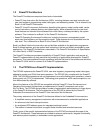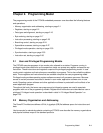
Overview 1-5
unnecessary line fills and enabling the ICU to handle the next EXU fetch. Aborting abandoned
requests also eliminates unnecessary external bus activity to increase external bus utilization.
1.4.1.2 Data Cache Unit
The DCU transfers 1, 2, 3, 4, or 8 bytes per cycle, depending on the number of byte enables
presented by the CPU. The DCU contains a single-element command and store data queue to reduce
pipeline stalls; this queue enables the DCU to independently process load/store and cache control
instructions. Dynamic PLB request prioritization reduces pipeline stalls even further. When the DCU is
busy with a low-priority request while a subsequent storage operation requested by the CPU is
stalled, the DCU automatically increases the priority of the current request to the PLB.
The DCU uses a two-line flush queue to minimize pipeline stalls caused by cache misses. Line
flushes are postponed until after a line fill is completed. Registers comprise the first position of the
flush queue; the line buffer built into the output of the array for manufacturing test serves as the
second position of the flush queue. Pipeline stalls are further reduced by forwarding the requested
word to the CPU during the line fill. Single-queued flushes are non-blocking. When a flush operation
is pending, the DCU can continue to access the array to determine subsequent load or store hits.
Under these conditions, load hits can occur concurrently with store hits to write-back memory without
stalling the pipeline. Requests abandoned by the CPU can also be aborted by the cache controller.
Additional DCU features enable the programmer to tailor performance for a given application. The
DCU can function in write-back or write-through mode, as controlled by the Data Cache Write-through
Register (DCWR) or the translation look-aside buffer (TLB). DCU performance can be tuned to
balance performance and memory coherency. Store-without-allocate, controlled by the SWOA field of
the Core Configuration Register 0 (CCR0), can inhibit line fills caused by store misses to further
reduce potential pipeline stalls and unwanted external bus traffic. Similarly, load-without-allocate,
controlled by CCR0[LWOA], can inhibit line fills caused by load misses.
1.4.2 Memory Management Unit
The 4GB address space of the PPC405 is presented as a flat address space.
The MMU provides address translation, protection functions, and storage attribute control for
embeddedembedded applications. The MMU supports demand paged virtual memory and other
management schemes that require precise control of logical to physical address mapping and flexible
memory protection. Working with appropriate system level software, the MMU provides the following
functions:
• Translation of the 4GB logical address space into physical addresses
• Independent enabling of instruction and data translation/protection
• Page level access control using the translation mechanism
• Software control of page replacement strategy
• Additional control over protection using zones
• Storage attributes for cache policy and speculative memory access control
The MMU can be disabled under software control. If the MMU is not used, the PPC405 core provides
other storage control mechanisms.
The translation lookaside buffer (TLB) is the hardware resource that controls translation and
protection. It consists of 64 entries, each specifying a page to be translated. The TLB is fully


















